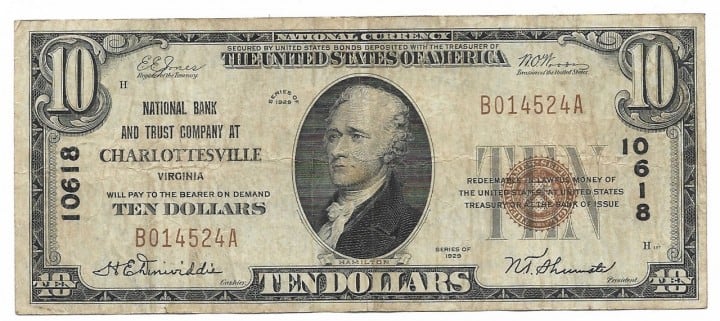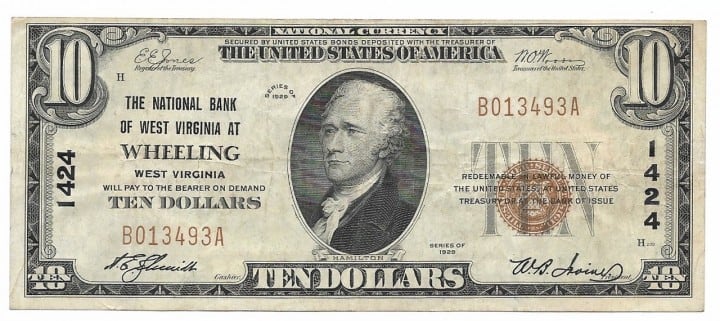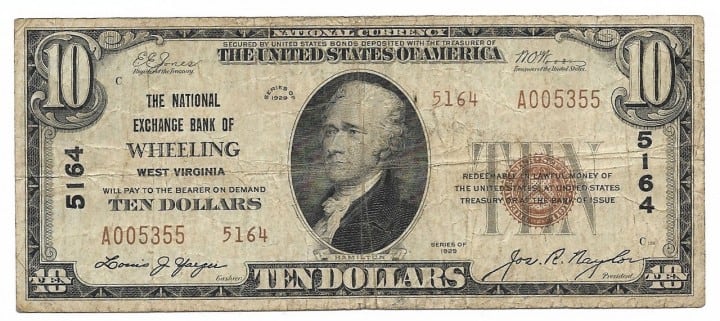Small-Size National Bank Notes
National Bank Notes are one of the most complex and interesting areas of U.S. numismatics. Over a seventy-year span of time, Nationals were issued by over 14,000 federally-chartered banks, located throughout the U.S. and in U.S. Territories. The names of these banks featured prominently on all of the note faces, including the names of local towns and cities where the banks were based. As a result of this prominence of town names, Nationals are sometimes known as “hometown notes.”
National Bank Notes were first authorized by the National Banking Acts of 1863 and 1864. The notes were backed by bonds placed on deposit at the U.S. Treasury by chartered member banks. Member banks submitted to federal oversight and were required to maintain, at minimum, set balances of capitol. The quantity of notes that a bank could issue was in direct proportion to the amount that they maintained on deposit with the Treasury. The program was designed, in large measure, to end the era of “wildcat banking” that had been predominant before the Civil War – wherein a virtual free-for-all of unregulated banking led to a proliferation of legitimate and illegitimate banknotes and private scrip circulating side-by-side. The National Bank system provided a uniform and reliable currency throughout the U.S. and was a precursor to the establishment of the Federal Reserve in 1913.
The vast majority of National Bank Notes were issued during the large-size era. Small-size Nationals were issued, though, in the Series of 1929. Denominations were $5, $10, $20, $50 and $100. Not all banks issued all denominations of notes. All Nationals were printed by the federal government and shipped to the member banks, who then issued the notes.
Small Nationals are less ornate than large Nationals and are more consistent with the other types of U.S. currency introduced with the Series of 1928. Portraits are the same as on Federal Reserve Notes, Silver Certificates, United States Notes, etc… Small nationals are, as a general rule, more abundant than their larger cousins, but there are some rarities within the vast series. As a general rule, banks in large cities usually issued more notes than banks in smaller towns. As a result, notes from larger cities are usually more common. Small-size Nationals come in two main varieties, known as “Type 1” and “Type 2” notes – the main difference between these two types being the addition of the bank’s charter number in brown alongside the serial number on “type 2” notes.
Small-size National Bank Notes superficially resemble a different series of U.S. currency, the small-size Federal Reserve Bank Notes, which were issued in 1933 (although dated Series of 1929). These Federal Reserve Bank Notes were an emergency issue intended to help stabilize the U.S. economy during the depths of the Great Depression. These notes also feature brown seals and serial numbers, similar to Series of 1929 National Bank Notes. The small Federal Reserve Bank Notes, or “FRBN’s,” were actually printed using plates intended for National Bank Notes, although they bear the names of Federal Reserve Banks in place of National Banks.
The issuance of National Bank Notes ended in 1935. At that point, many were redeemed & destroyed. All that survive remain legal tender, but are also highly collectible. The possibilities for collecting Nationals are nearly endless – some choose to focus on particular banks or towns, often one’s hometown, place of birth, or places of residence. Other approaches include collecting a particular county, state, or region. Some collectors focus on notes issued by U.S. Territories, or aim to acquire a note from each state. Collecting particular series, or notes issued only from banks in state capitals are also popular approaches.



